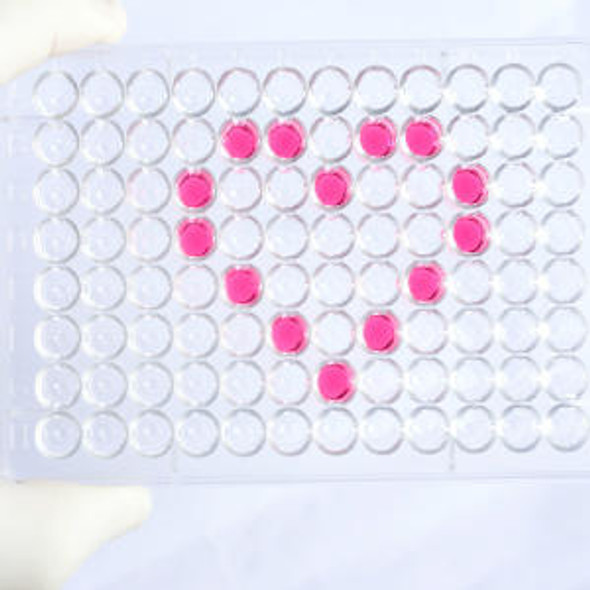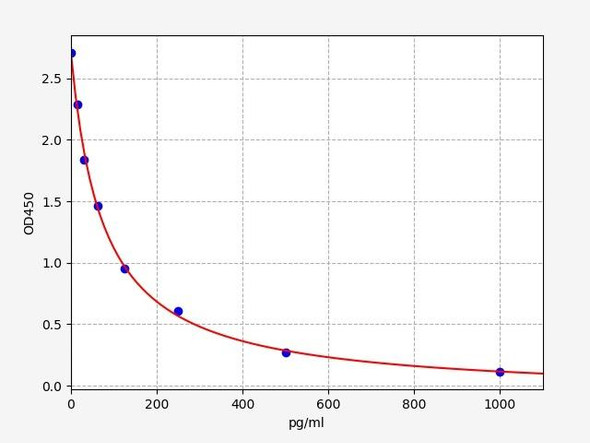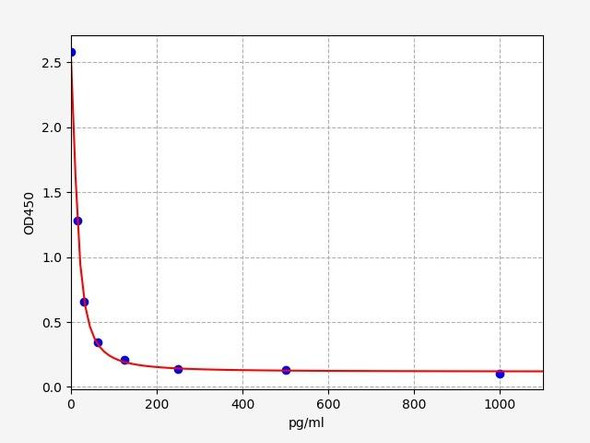Description
Human ACTH ELISA Kit
Adrenocorticotropic hormone (ACTH) is a peptide hormone that is secreted by the anterior pituitary gland and stimulates the production and release of glucocorticoids from the adrenal cortex. The ACTH is released in response to a stressor, such as an exercise, hypoglycemia, or pain. ACTH plays a key role in the function of the sympathetic nervous system. It is used as a marker for stress and has been associated with the symptoms of chronic stress such as anxiety, depression, and insomnia. The most common cause of ACTH deficiency is surgical removal or destruction of part or all of one or both adrenal glands.
| Product Name: | Human ACTH ELISA Kit |
| Product Code: | HUFI00819 |
| Size: | 96 Assays |
| Alias: | ACTH, Adrenocorticotropic Hormone, Corticotropin, Adrenocorticotropin |
| Detection method: | Competitive ELISA, Coated with Antibody |
| Application: | This immunoassay kit allows for the in vitro quantitative determination of Human ACTH concentrations in serum plasma and other biological fluids. |
| Sensitivity: | 9.375pg/ml |
| Range: | 15.625-1000pg/ml |
| Storage: | 4°C for 6 months |
| Note: | For Research Use Only |
| Recovery: | Matrices listed below were spiked with certain level of Human ACTH and the recovery rates were calculated by comparing the measured value to the expected amount of Human ACTH in samples. | ||||||||||||||||
| |||||||||||||||||
| Linearity: | The linearity of the kit was assayed by testing samples spiked with appropriate concentration of Human ACTH and their serial dilutions. The results were demonstrated by the percentage of calculated concentration to the expected. | ||||||||||||||||
| |||||||||||||||||
| CV(%): | Intra-Assay: CV<8% Inter-Assay: CV<10% |
| Component | Quantity | Storage |
| ELISA Microplate(Dismountable) | 8×12 strips | 4°C for 6 months |
| Lyophilized Standard | 2 | 4°C/-20°C |
| Sample/Standard Dilution Buffer | 20ml | 4°C |
| Biotin-labeled Antibody(Concentrated) | 60ul | 4°C (Protect from light) |
| Antibody Dilution Buffer | 10ml | 4°C |
| HRP-Streptavidin Conjugate(SABC) | 120ul | 4°C (Protect from light) |
| SABC Dilution Buffer | 10ml | 4°C |
| TMB Substrate | 10ml | 4°C (Protect from light) |
| Stop Solution | 10ml | 4°C |
| Wash Buffer(25X) | 30ml | 4°C |
| Plate Sealer | 5 | - |
Other materials and equipment required:
- Microplate reader with 450 nm wavelength filter
- Multichannel Pipette, Pipette, microcentrifuge tubes and disposable pipettetips
- Incubator
- Deionized or distilled water
- Absorbent paper
- Buffer resevoir
| Uniprot | P01189 |
| UniProt Protein Function: | POMC: ACTH stimulates the adrenal glands to release cortisol. Defects in POMC may be associated with susceptibility to obesity (OBESITY). It is a condition characterized by an increase of body weight beyond the limitation of skeletal and physical requirements, as the result of excessive accumulation of body fat. Defects in POMC are the cause of pro-opiomelanocortinin deficiency (POMCD). Affected individuals present early-onset obesity, adrenal insufficiency and red hair. Belongs to the POMC family. |
| UniProt Protein Details: | Protein type:Secreted, signal peptide; Secreted Chromosomal Location of Human Ortholog: 2p23.3 Cellular Component: peroxisomal matrix; extracellular space; cytoplasm; extracellular region; peroxisome; secretory granule Molecular Function:type 3 melanocortin receptor binding; G-protein-coupled receptor binding; type 4 melanocortin receptor binding; hormone activity; receptor binding Biological Process: generation of precursor metabolites and energy; cellular protein metabolic process; cell-cell signaling; neuropeptide signaling pathway; regulation of blood pressure; peptide hormone processing; regulation of appetite; positive regulation of transcription from RNA polymerase II promoter; negative regulation of tumor necrosis factor production; signal transduction; glucose homeostasis; cellular pigmentation Disease: Obesity; Proopiomelanocortin Deficiency |
| NCBI Summary: | This gene encodes a polypeptide hormone precursor that undergoes extensive, tissue-specific, post-translational processing via cleavage by subtilisin-like enzymes known as prohormone convertases. There are eight potential cleavage sites within the polypeptide precursor and, depending on tissue type and the available convertases, processing may yield as many as ten biologically active peptides involved in diverse cellular functions. The encoded protein is synthesized mainly in corticotroph cells of the anterior pituitary where four cleavage sites are used; adrenocorticotrophin, essential for normal steroidogenesis and the maintenance of normal adrenal weight, and lipotropin beta are the major end products. In other tissues, including the hypothalamus, placenta, and epithelium, all cleavage sites may be used, giving rise to peptides with roles in pain and energy homeostasis, melanocyte stimulation, and immune modulation. These include several distinct melanotropins, lipotropins, and endorphins that are contained within the adrenocorticotrophin and beta-lipotropin peptides. The antimicrobial melanotropin alpha peptide exhibits antibacterial and antifungal activity. Mutations in this gene have been associated with early onset obesity, adrenal insufficiency, and red hair pigmentation. Alternatively spliced transcript variants encoding the same protein have been described. [provided by RefSeq, Nov 2014] |
| UniProt Code: | P01189 |
| NCBI GenInfo Identifier: | 116880 |
| NCBI Gene ID: | 5443 |
| NCBI Accession: | P01189.2 |
| UniProt Secondary Accession: | P01189,P78442, Q53T23, Q9UD39, Q9UD40, |
| UniProt Related Accession: | P01189 |
| Molecular Weight: | 267 |
| NCBI Full Name: | Pro-opiomelanocortin |
| NCBI Synonym Full Names: | proopiomelanocortin |
| NCBI Official Symbol: | POMC |
| NCBI Official Synonym Symbols: | LPH; MSH; NPP; POC; ACTH; CLIP |
| NCBI Protein Information: | pro-opiomelanocortin; beta-LPH; beta-MSH; alpha-MSH; gamma-LPH; gamma-MSH; beta-endorphin; met-enkephalin; lipotropin beta; lipotropin gamma; melanotropin beta; melanotropin alpha; melanotropin gamma; pro-ACTH-endorphin; adrenocorticotropin; corticotropin-lipotropin; adrenocorticotropic hormone; opiomelanocortin prepropeptide; proopiomelanocortin preproprotein; beta-melanocyte-stimulating hormone; alpha-melanocyte-stimulating hormone; corticotropin-like intermediary peptide |
| UniProt Protein Name: | Pro-opiomelanocortin |
| UniProt Synonym Protein Names: | Corticotropin-lipotropinCleaved into the following 11 chains:NPP; Melanotropin gammaAlternative name(s):Gamma-MSH |
| Protein Family: | Pro-opiomelanocortin |
| UniProt Gene Name: | POMC |
| UniProt Entry Name: | COLI_HUMAN |
*Note: Protocols are specific to each batch/lot. For the correct instructions please follow the protocol included in your kit.
Equilibrate the TMB substrate for at least 30 min at 37°C beforeuse. When diluting samples and reagents, they must be mixed completely andevenly. It is recommended to plot a standard curve for each test.
| Step | Protocol |
| 1. | Set standard, test sample and control (zero) wells on the pre-coatedplate respectively, and then, record their positions. It isrecommended to measure each standard and sample in duplicate. Washplate 2 times before adding standard, sample and control (zero) wells! |
| 2. | Add Sample and Biotin-detection antibody: Add 50µL of Standard, Blank or Sample per well. The blankwell is added with Sample Dilution Buffer. Immediately add 50 µL of biotin-labelled antibody workingsolution to each well. Cover with the plate sealer provided. Gently tap the plate to ensure thoroughmixing. Incubate for 45 minutes at 37°C. (Solutions are added to the bottom of micro-ELISA platewell, avoid touching plate walls and foaming). |
| 3. | Wash: Aspirate each well and wash, repeating the process three timesWash by filling each well with Wash Buffer (approximately 350µL)using a squirt bottle, multi-channel pipette, manifold dispenser orautomated washer. Complete removal of liquid at each step is essentialto good performance. After the last wash, remove any remaining WashBuffer by aspirating or decanting. Invert the plate and pat it againstthick clean absorbent paper. |
| 4. | HRP-Streptavidin Conjugate(SABC): Add 100µL of SABC workingsolution to each well. Cover with a new Plate sealer. Incubate for30minutes at 37°C. |
| 5. | Wash: Repeat the aspiration/wash process for five times. |
| 6. | TMB Substrate: Add 90µL of TMB Substrate to each well. Coverwith a new Plate sealer. Incubate for about 10-20 minutes at 37°C.Protect from light. The reaction time can be shortened or extendedaccording to the actual color change, but not more than 30minutes.When apparent gradient appeared in standard wells, you can terminatethe reaction. |
| 7. | Stop: Add 50µL of Stop Solution to each well. Color turn toyellow immediately. The adding order of stop solution should be as thesame as the substrate solution. |
| 8. | OD Measurement: Determine the optical density (OD Value) of each wellat once, using a microplate reader set to 450 nm. You should open themicroplate reader ahead, preheat the instrument, and set the testing parameters. |
When carrying out an ELISA assay it is important to prepare your samples in order to achieve the best possible results. Below we have a list of procedures for the preparation of samples for different sample types.
| Sample Type | Protocol |
| Serum | If using serum separator tubes, allow samples to clot for 30 minutes at room temperature. Centrifuge for 10 minutes at 1,000x g. Collect the serum fraction and assay promptly or aliquot and store the samples at -80°C. Avoid multiple freeze-thaw cycles. If serum separator tubes are not being used, allow samples to clot overnight at 2-8°C. Centrifuge for 10 minutes at 1,000x g. Remove serum and assay promptly or aliquot and store the samples at -80°C. Avoid multiple freeze-thaw cycles. |
| Plasma | Collect plasma using EDTA or heparin as an anticoagulant. Centrifuge samples at 4°C for 15 mins at 1000 × g within 30 mins of collection. Collect the plasma fraction and assay promptly or aliquot and store the samples at -80°C. Avoid multiple freeze-thaw cycles. Note: Over haemolysed samples are not suitable for use with this kit. |
| Urine & Cerebrospinal Fluid | Collect the urine (mid-stream) in a sterile container, centrifuge for 20 mins at 2000-3000 rpm. Remove supernatant and assay immediately. If any precipitation is detected, repeat the centrifugation step. A similar protocol can be used for cerebrospinal fluid. |
| Cell culture supernatant | Collect the cell culture media by pipette, followed by centrifugation at 4°C for 20 mins at 1500 rpm. Collect the clear supernatant and assay immediately. |
| Cell lysates | Solubilize cells in lysis buffer and allow to sit on ice for 30 minutes. Centrifuge tubes at 14,000 x g for 5 minutes to remove insoluble material. Aliquot the supernatant into a new tube and discard the remaining whole cell extract. Quantify total protein concentration using a total protein assay. Assay immediately or aliquot and store at ≤ -20 °C. |
| Tissue homogenates | The preparation of tissue homogenates will vary depending upon tissue type. Rinse tissue with 1X PBS to remove excess blood & homogenize in 20ml of 1X PBS (including protease inhibitors) and store overnight at ≤ -20°C. Two freeze-thaw cycles are required to break the cell membranes. To further disrupt the cell membranes you can sonicate the samples. Centrifuge homogenates for 5 mins at 5000xg. Remove the supernatant and assay immediately or aliquot and store at -20°C or -80°C. |
| Tissue lysates | Rinse tissue with PBS, cut into 1-2 mm pieces, and homogenize with a tissue homogenizer in PBS. Add an equal volume of RIPA buffer containing protease inhibitors and lyse tissues at room temperature for 30 minutes with gentle agitation. Centrifuge to remove debris. Quantify total protein concentration using a total protein assay. Assay immediately or aliquot and store at ≤ -20 °C. |
| Breast Milk | Collect milk samples and centrifuge at 10,000 x g for 60 min at 4°C. Aliquot the supernatant and assay. For long term use, store samples at -80°C. Minimize freeze/thaw cycles. |
Fill out our quote form below and a dedicated member of staff will get back to you within one working day!






